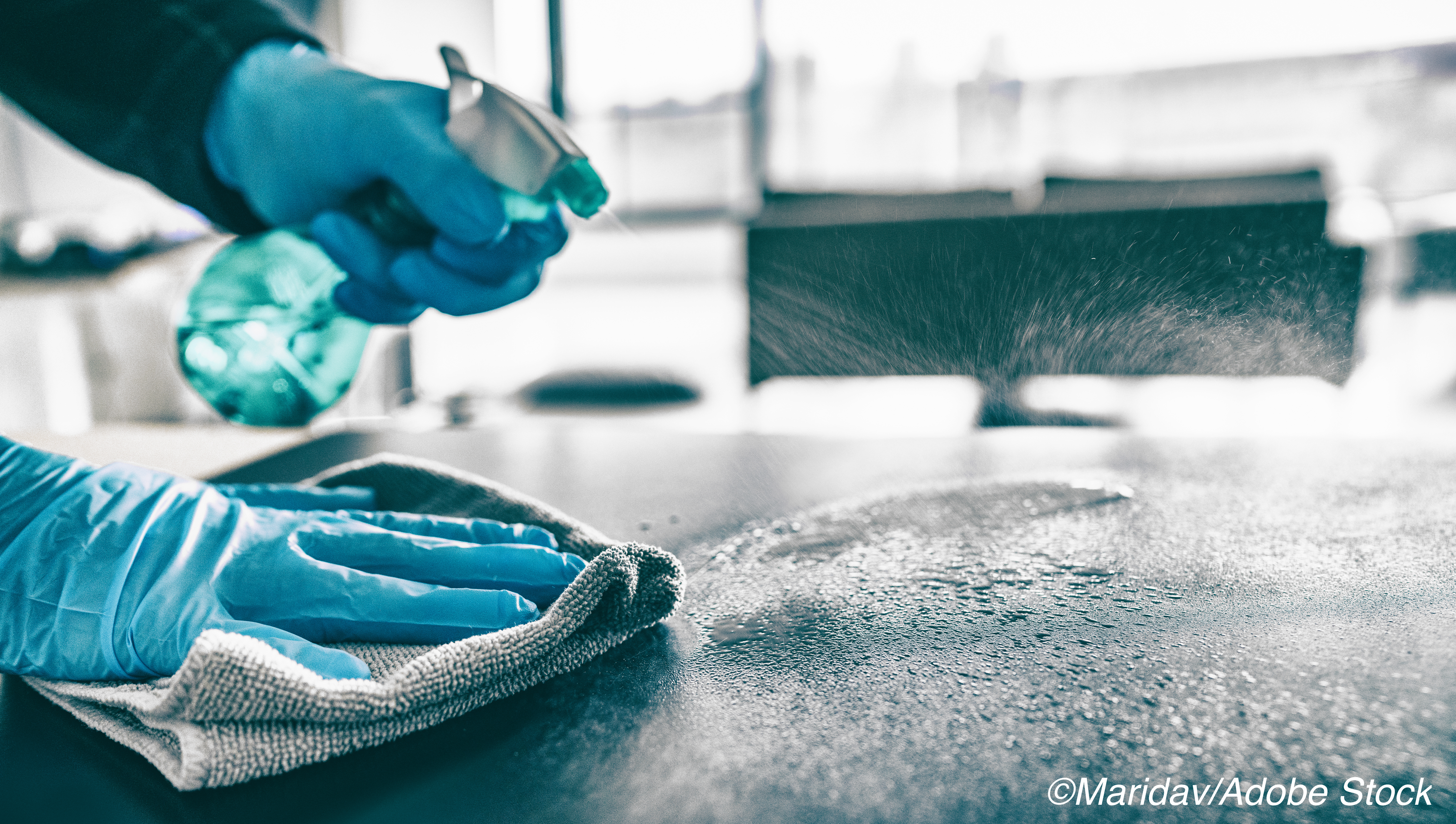
Household cleaners and disinfectants flew off store shelves as the U.S. braced to combat the Covid-19 pandemic. However, a recent survey of U.S. adults revealed a substantial lack of knowledge about how to properly store and use these products, with nearly 40% of respondents admitting to high-risk practices.
The U.S. has seen a substantial increase in calls to poison centers due to exposure to household cleaners and disinfectants since the start of the pandemic, noted Radhika Gharpure, DVM, of the CDC’s Covid-19 Response Team and Epidemic Intelligence Service, and colleagues in Morbidity and Mortality Weekly Report. In order to better understand how poisoning victims were using these products, Gharpure and colleagues conducted an opt-in internet panel survey of 502 U.S. adults in May 2020 to assess “general knowledge, attitudes, and practices related to use of household cleaners and disinfectants,” as well as specific household disinfection strategies for Covid-19.
The median age of respondents was 46 years, 52% were female, and 63% were non-Hispanic white.
“Participants had limited knowledge of safe preparation of cleaning and disinfectant solutions,” they found. “Overall, 23% responded that only room temperature water should be used for preparation of dilute bleach solutions, 35% that bleach should not be mixed with vinegar, and 58% that bleach should not be mixed with ammonia. In comparison, a higher percentage of respondents had knowledge about use of recommended personal protective equipment: 64% responded that eye protection was recommended for use of some cleaners and disinfectants, and 71% responded that gloves were recommended for use. Similarly, 68% responded that handwashing was recommended after using cleaners and disinfectants and 73% that adequate ventilation was recommended when using these products. Regarding safe storage of cleaners, disinfectants, and hand sanitizers, 79% of respondents said that cleaners and disinfectants should be kept out of the reach of children, and 54% that hand sanitizers should be kept out of the reach of children.”
Sixty percent of respondents reported cleaning and disinfecting their homes more frequently compared to the months preceding the pandemic. When asked whether they agreed that they knew how to properly clean and disinfect their home, 51% and 31% strongly agreed and somewhat agreed, respectively; 42% and 35% strongly agreed and somewhat agreed, respectively, that they knew how to clean and disinfect their home to prevent transmission of SARS-CoV-2.
But, alarmingly, 39% reported intentionally engaging in unrecommended, high-risk practices to prevent the virus, “including application of bleach to food items (e.g., fruits and vegetables) (19%); use of household cleaning and disinfectant products on hands or skin (18%); misting the body with a cleaning or disinfectant spray (10%); inhalation of vapors from household cleaners or disinfectants (6%); and drinking or gargling diluted bleach solutions, soapy water, and other cleaning and disinfectant solutions (4% each),” they wrote.
Twenty-five percent of respondents reported at least one adverse event related to cleaner/disinfectant use in the preceding month, including nose or sinus irritation (11%); skin irritation (8%); eye irritation (8%); dizziness, lightheadedness, or headache (8%); upset stomach or nausea (6%); or breathing problems (6%).
“Respondents who reported engaging in at least one high-risk practice more frequently reported an adverse health effect than did those who did not report engaging in such practices (39% versus 16%),” they added.
“This survey identified important knowledge gaps in the safe use of cleaners and disinfectants among U.S. adults; the largest gaps were found in knowledge about safe preparation of cleaning and disinfectant solutions and about storage of hand sanitizers out of the reach of children,” Gharpure and colleagues wrote. “Mixing of bleach solutions with vinegar or ammonia, as well as application of heat, can generate chlorine and chloramine gases that might result in severe lung tissue damage when inhaled. Furthermore, exposures of children to hand sanitizers, particularly via ingestion, can be associated with irritation of mucous membranes, gastrointestinal effects, and in severe cases, alcohol toxicity. The risk of ingestion and consequent toxicity from improperly stored hand sanitizers, cleaners, and disinfectants can also extend to pets.”
The report authors noted that Covid-19 prevention messaging from the CDC and other sources should continue to provide evidence-based practices for cleaning and disinfecting their homes, along with specific recommendations for safely using household cleaning products.
“Despite the knowledge gaps and high-risk practices identified in this survey, most respondents believed that they knew how to clean and disinfect their homes safely; thus, prevention messages should highlight identified gaps in knowledge about safe and effective practices and provide targeted information using innovative communication strategies (e.g., digital, social media) regarding safe cleaning and disinfection,” they wrote. “These messages about cleaning and disinfection practices for Covid-19 prevention can be coordinated and disseminated through trusted sources of information such as national, state, and local public health agencies and medical providers.”
Gharpure and colleagues noted four limitations to their findings. First, while survey responses were weighted to be nationally representative, it is difficult to determine whether the responses are truly representative of the broader U.S. population; Second, social desirability bias may have prompted respondents to either overstate their perceived knowledge or underreport high-risk practices; Third, they could not attribute specific adverse health outcomes to specific knowledge gaps or practices; and Fourth, responses were collected at a single point in time and might not reflect changes in public opinion or cleaning and disinfection practices as the pandemic continues.
John McKenna, Associate Editor, BreakingMED™
No potential conflicts of interest were disclosed.
Cat ID: 125
Topic ID: 79,125,730,933,125,190,520,926,192,927,151,590,928


